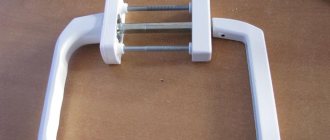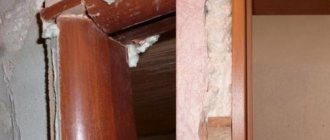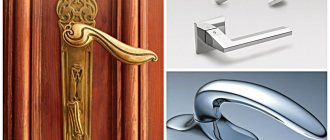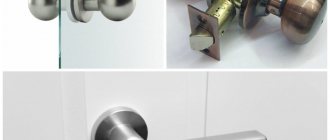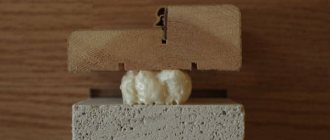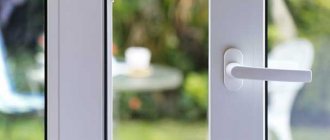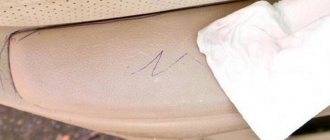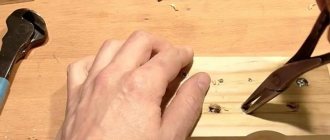Brief instructions on how to disassemble a door handle will familiarize the reader with this simple process.
Kinds
According to the installation method, there are 2 types of handles:
- invoices;
- mortise
Overlay fittings are installed on the door leaf using a strip; for a mortise design, there must be a hole in the door.
By purpose there are:
- input;
- interior.
Based on functionality, door products are divided into 2 types:
- movable;
- stationary.
Movable handles are available in 2 versions:
- rotary (knobs and buttons);
- push.
The analysis of a door handle depends on its type and design features.
Design features
Stationary handles are produced without latches or locks. The fastening elements to the door block are screws or self-tapping screws. Such fixed structures are decorative in nature and serve solely for the movement of the door. They can be 1-sided or 2-sided of different shapes, connected by an axial element. They are installed on interior or plastic balcony door blocks, rarely on entrance ones.
Pressure products are 2 L-shaped levers, which are connected by a rod passing through the door block. In such a device, when turning, the halyard tongue enters the inside of the door and locks it. Using the elements, external and interior doors are mounted.
The main advantage of the model is its reliability. The failure rate of push mechanisms is much lower than others.
The rotary mechanism is most often made in the form of a ball or button with a diameter of 50-60 mm with a lock located in the center of the round handle. The keyhole can have a 2-way exit or 1-way with a latch. The door opens with a simple twist. Such fittings may also contain a door opening blocker. Therefore, they are often used in door structures of bathrooms and interior units, and are also called knob handles.
They are compact, easy to install, and low in price, but have disadvantages such as low strength and fragility due to jamming of spare parts inside the mechanism.
Rotary and push products differ in the shape and method of opening the latch.
Components of the mechanism
Pivot and push door products for interior doors have the following spare parts and components:
- pen;
- latch;
- strip or socket;
- decorative flange;
- fasteners;
- special key for squeezing and removing the mechanism.
The door hardware kit with keyhole is supplied with keys.
Required Tools
Diagram of an interior door lock with a handle
As we learned from a small example, the repair work of interior push-button or round sets is a fairly simple task, however, it requires some attention and a responsible approach to solving the problem.
It is worth noting that in the case of disassembling turnkey fittings, you may encounter complex locks that are almost impossible to repair yourself. In this case, it is easier to replace them with a new headset or entrust the work to a specialist.
Door handles are now available in a variety of shapes and designs, but in general they can be classified as follows:
Before you begin disassembling a broken handle, you need to determine its type, since this will determine how to disassemble it.
After finding out the type of handle (whether it has a snap mechanism or is it regular), they begin to disassemble it.
Reasons for disassembly
Disassembling door handles is an infrequent procedure, which is resorted to in the case of loose, “loose” fittings that require tightening the screws or fixing the problem. The main reasons for disassembling round handles are:
- Failure of the product due to careless handling, end of service life or lack of preventive procedures (lubricating the mechanism, tightening loose screws and self-tapping screws);
- Jamming of the locking mechanism due to sagging of the door leaf not being corrected in a timely manner or poor-quality installation that is not level;
- Changing the product to a new one that is more modern or more suitable in style to the room;
- A worn, wrinkled, unsightly appearance that appears during the service life, the duration of which depends on the quality of the material and coating of the handle;
- Installation of new interior doors, in which thrifty owners install handles in good condition from old panels.
Required Tools
To disassemble the door handle, you will need to have a certain tool on hand. Regardless of its type, there may be some hidden elements and parts in it that cannot always be pulled out using conventional tools.
For this reason, you should have the following list of tools on hand:
- hammer;
- screwdriver;
- drill and set of drills with a crown;
- pencil;
- awl;
- square
Common breakdowns
How to disassemble the handle of an interior door? This question arises during various breakdowns when repairs are necessary. Here are the most common malfunctions that appear over time:
- sticking of the handle - this problem primarily concerns push models; they can jam when pressing the lever, so you have to make an effort to open or close the door;
- jamming of the latch - even when the handle itself works perfectly, the latch may jam, which is why operating the door also becomes a problem;
- the handle has become loose - over time, this almost inevitably happens even with the best and most expensive products; due to the weakening of the fastenings during intensive use, the handle begins to come off and wobble when touched, and the entire locking mechanism itself may suffer;
- the handle does not take its original position - the push model always returns to its original position after it is released; when it remains lowered or raised, this is a sure sign of a malfunction;
- The tongue does not extend or hide inside the mechanism - another common problem that causes difficulty closing the door.
Disassembling a stationary handle
If the product is fixed with self-tapping screws, then it is enough to unscrew the screws with a flat screwdriver and remove the fittings. Inspect for damage. If it cannot be repaired, then it must be replaced.
When placing the product on a common rod, it is enough to remove the fastening fragment from one side. The structure must be removed from the reverse side. The presence of a rod in the product is checked by turning it counterclockwise while simultaneously holding it with your hand on the other side. If you can turn it, then it is on the rod.
The stationary handle with built-in latch can be removed with a screwdriver, unscrewing the screws and removing the decorative trim.
Disassembling rotary handles
To disassemble the round handle, you need to prepare:
- special wrench to loosen the locking pin. The key comes complete with a handle. If the special device is lost, you can use any hex key that fits the diameter;
- screwdriver
The handle is disassembled as follows:
- On the decorative trim you need to find a hole for a hex key. It is most often located below or on the side;
- The key is inserted into the hole and pressed lightly. In this way, the locking pin is loosened;
- The other hand removes the handle. To do this, just pull the device towards you;
- at the next stage, the decorative trim covering the hole in the door leaf is removed;
- Under the cover there are mounting bolts that need to be loosened using a screwdriver. After performing this operation, the door handle splits into two parts.
The process of disassembling the rotary knob
Location of door handle fasteners
If you need to replace the rotary knob, you will also need to remove the latch. To do this, simply unscrew the fastening screws located on the end part of the interior door and fixing the corresponding mechanism.
Making holes in the door leaf
First you need to make a through cylindrical hole. To do this, use a tape measure to measure a distance of 1 - 1.2 m from the floor. Make a mark with a pencil. From the end of the door, measure a distance equal to the length of the latch mechanism. You can measure the mechanism using a ruler or look at its parameters in the manufacturer's instructions (all the drawings should be there). The resulting intersection point will be the center of the hole.
First, use a drill to make a hole with a diameter of 5–6 mm. Then install a bit on the drill, the diameter of which is equal to the diameter of the hole for the internal mechanism of the handle - as a rule, it is indicated in the instructions.
Helpful advice! To make a neat through hole in the door leaf using a crown, first make a shallow cut on one side of the door - 5 or 10 mm. After this, a through hole is made on the other side of the door, centering the crown along the hole from the drill.
Thus, when the crown comes out from the back side, the decorative coating will not peel off along the edges.
At the end of the door, according to the markings, you need to prepare a hole for the latch. To do this, a drill with a feather drill is used to make a hole. If it is too small, you can widen it with a chisel. Using the same hand tool, a small recess is made under the groove of the plate, which will be screwed from the end.
Disassembling lever handles
To disassemble the handle with a pressure mechanism, you will need a screwdriver that is most suitable for the mounting bolts.
The disassembly process is carried out according to the following scheme:
- The first step is to remove the decorative trim. The cover can be attached in two ways:
- using thread. To remove the element, you need to turn the cover several times counterclockwise;
- using a locking tab. To remove the cover, you will need to move the tongue slightly in any direction with a sharp tool;
If, due to contamination or damage, the cover does not come off, you can use a screwdriver and a hammer. A screwdriver is inserted between the trim and the door. Hitting the screwdriver handle with a hammer allows you to move the mechanism and unscrew it completely.
- the next step is to unscrew the bolt located at the bottom of the handle. Using this fastening element, the handle itself is fixed to the mechanism with a latch;
- under the decorative cover there are two or three screws that secure the main mechanism;
Lever handle fastening elements
- After unscrewing all the fasteners, the handle can be pulled out freely.
Removing the handle from an interior door
The locking mechanism of the push handle is removed in the same way as handles with a rotary system.
After familiarizing yourself with the proposed diagrams for disassembling door handles, you can repair or replace the device without the help of a specialist. To install the handle, you can follow the instructions included with the new device or perform all the steps indicated in the diagrams in reverse order.
How to disassemble and remove?
Removing a door handle is quite simple if you have the above-mentioned tools, as well as a little theoretical knowledge of the structure of this mechanism.
To do this, you must follow these steps.
- Support and secure the door well so that it is in a stationary position.
- Now you need to pry up the decorative flange and pull it out a little. Underneath there are fasteners that need to be unscrewed.
- On the mentioned flange of the pressure part there is a special pin, which is locking and spring-loaded. It should be pressed in using a screwdriver. In rotary versions it is usually located in the housing. To get there, you need to insert a key or an awl. If you cannot feel it, then you should rotate the flange until it comes into contact with the pin.
- Now you should press the pin and at the same moment pull out the handle structure.
- Now unscrew the fastening bolts.
- We separate the inside of the element from the outside, take out the handle and the decorative flange.
If there is a need to remove the latch for replacement or repair, then you should unscrew the screws that secure it to the side of the door block, then remove the bar, and then the mechanism itself.
When installing fittings to a different position, it is better not to disassemble it for spare parts. It is easily attached to the door structure, but in the reverse order.
Now we’ll tell you directly about the disassembly of each category of handles.
Let's start with the stationary one, which does not have a push set, and is also not equipped with a mortise lock. In order to unscrew such a handle, you will need a Phillips or flat-head screwdriver. Alternatively, you can use a screwdriver. Dismantling must begin by loosening the screws that secure the mechanism.
If there are decorative elements, they must first be removed. As you unscrew the bolts, you should hold the counter parts on the back side of the blade. If this is not done, the structure may simply fall out of the canvas and become deformed.
It should be noted that the fastening can be one- or two-sided; accordingly, the structure can be disassembled in different ways, which means that this must be taken care of in advance.
When all the bolts are unscrewed, you need to carefully remove the handle from the door leaf using a flat-tip screwdriver. In place of the old handle, another mechanism is installed or the same design, but with new spare parts.
If we are talking about disassembling a round handle with a socket, then it is necessary to clarify that the word “socket” is usually understood as a mechanism that allows you to lock the lock using a small key on one side, which is not used on the other side. There is a special lamb on the second side.
In this situation, disassembling the mechanism will be carried out according to the following algorithm:
- first loosen the screws that hold the linings that perform a decorative function on both sides;
- the screws connecting the mechanism on both sides are unscrewed;
- the handle structure is pulled out and the remaining part is removed;
- The locking mechanism is pulled out.
If the handle requires repair or any part of it needs to be replaced, then you should completely disassemble the individual elements and determine the cause of the malfunction. It is necessary to especially carefully monitor the safety of all small structural elements, otherwise if they are lost, it will simply not be possible to put the mechanism back together.
Now let's talk about disassembling the round knob handle. To remove this element from the door leaf, the following steps are usually performed.
- The fastening bolts on one side of the door are unscrewed.
- The mechanism is dismantled through special holes.
- The additional counter-type strip is disassembled. To dismantle this element, simply pull it in your direction.
The non-removable round handle is fixed using the simplest screws for fastening. This mechanism is made with the expectation that later no repair work will be carried out, but a new spare part will simply be purchased, which will take the place of the old handle.
Push options. Usually they are used instead of rotary solutions. This is due to the fact that they are durable and very easy to use and repair.
Disassembly is performed as follows:
- first, the screws holding the decorative cloth of the overhead type, which performs the function of a clamp, are unscrewed;
- after this careful removal of the overhead sheets located on both sides;
- the fastening bolts are unscrewed and the round-shaped structural elements located on both sides of the door leaf are pulled out;
- All that remains is to open the strike plate and the lock itself, and then pull them out of the fitting grooves.
Disassembling the round pen
Knob fittings with a lock take longer to dismantle than other devices due to their complex structure. However, let's figure out how to disassemble a round door handle. To do this, you must follow the following steps:
- First, use a screwdriver to remove the flat cover located near the handle;
- press the stopper with a key or other sharp object and pull the product towards you;
- from the removal side, the screws are unscrewed, both parts move away from the door leaf;
- the screws securing the latch are unscrewed.


